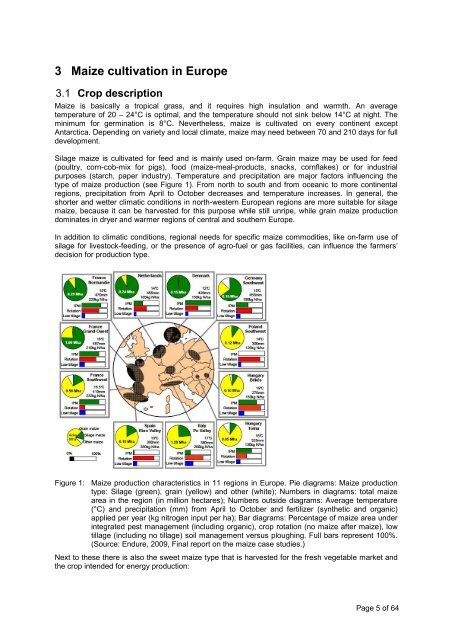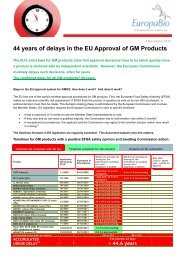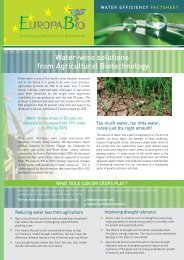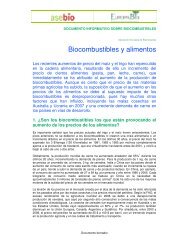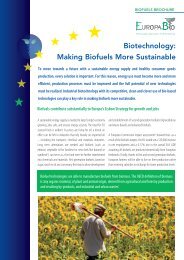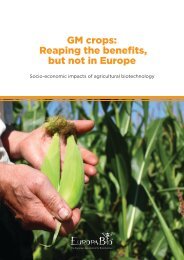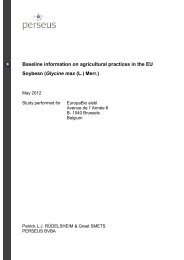Baseline information on agricultural practices in the EU ... - Europabio
Baseline information on agricultural practices in the EU ... - Europabio
Baseline information on agricultural practices in the EU ... - Europabio
Create successful ePaper yourself
Turn your PDF publications into a flip-book with our unique Google optimized e-Paper software.
3 Maize cultivati<strong>on</strong> <strong>in</strong> Europe<br />
3.1 Crop descripti<strong>on</strong><br />
Maize is basically a tropical grass, and it requires high <strong>in</strong>sulati<strong>on</strong> and warmth. An average<br />
temperature of 20 – 24°C is optimal, and <strong>the</strong> temperature should not s<strong>in</strong>k below 14°C at night. The<br />
m<strong>in</strong>imum for germ<strong>in</strong>ati<strong>on</strong> is 8°C. Never<strong>the</strong>less, maize is cultivated <strong>on</strong> every c<strong>on</strong>t<strong>in</strong>ent except<br />
Antarctica. Depend<strong>in</strong>g <strong>on</strong> variety and local climate, maize may need between 70 and 210 days for full<br />
development.<br />
Silage maize is cultivated for feed and is ma<strong>in</strong>ly used <strong>on</strong>-farm. Gra<strong>in</strong> maize may be used for feed<br />
(poultry, corn-cob-mix for pigs), food (maize-meal-products, snacks, cornflakes) or for <strong>in</strong>dustrial<br />
purposes (starch, paper <strong>in</strong>dustry). Temperature and precipitati<strong>on</strong> are major factors <strong>in</strong>fluenc<strong>in</strong>g <strong>the</strong><br />
type of maize producti<strong>on</strong> (see Figure 1). From north to south and from oceanic to more c<strong>on</strong>t<strong>in</strong>ental<br />
regi<strong>on</strong>s, precipitati<strong>on</strong> from April to October decreases and temperature <strong>in</strong>creases. In general, <strong>the</strong><br />
shorter and wetter climatic c<strong>on</strong>diti<strong>on</strong>s <strong>in</strong> north-western European regi<strong>on</strong>s are more suitable for silage<br />
maize, because it can be harvested for this purpose while still unripe, while gra<strong>in</strong> maize producti<strong>on</strong><br />
dom<strong>in</strong>ates <strong>in</strong> dryer and warmer regi<strong>on</strong>s of central and sou<strong>the</strong>rn Europe.<br />
In additi<strong>on</strong> to climatic c<strong>on</strong>diti<strong>on</strong>s, regi<strong>on</strong>al needs for specific maize commodities, like <strong>on</strong>-farm use of<br />
silage for livestock-feed<strong>in</strong>g, or <strong>the</strong> presence of agro-fuel or gas facilities, can <strong>in</strong>fluence <strong>the</strong> farmers’<br />
decisi<strong>on</strong> for producti<strong>on</strong> type.<br />
Figure 1: Maize producti<strong>on</strong> characteristics <strong>in</strong> 11 regi<strong>on</strong>s <strong>in</strong> Europe. Pie diagrams: Maize producti<strong>on</strong><br />
type: Silage (green), gra<strong>in</strong> (yellow) and o<strong>the</strong>r (white); Numbers <strong>in</strong> diagrams: total maize<br />
area <strong>in</strong> <strong>the</strong> regi<strong>on</strong> (<strong>in</strong> milli<strong>on</strong> hectares); Numbers outside diagrams: Average temperature<br />
(°C) and precipitati<strong>on</strong> (mm) from April to October and fertilizer (syn<strong>the</strong>tic and organic)<br />
applied per year (kg nitrogen <strong>in</strong>put per ha); Bar diagrams: Percentage of maize area under<br />
<strong>in</strong>tegrated pest management (<strong>in</strong>clud<strong>in</strong>g organic), crop rotati<strong>on</strong> (no maize after maize), low<br />
tillage (<strong>in</strong>clud<strong>in</strong>g no tillage) soil management versus plough<strong>in</strong>g. Full bars represent 100%.<br />
(Source: Endure, 2009, F<strong>in</strong>al report <strong>on</strong> <strong>the</strong> maize case studies.)<br />
Next to <strong>the</strong>se <strong>the</strong>re is also <strong>the</strong> sweet maize type that is harvested for <strong>the</strong> fresh vegetable market and<br />
<strong>the</strong> crop <strong>in</strong>tended for energy producti<strong>on</strong>:<br />
Page 5 of 64


